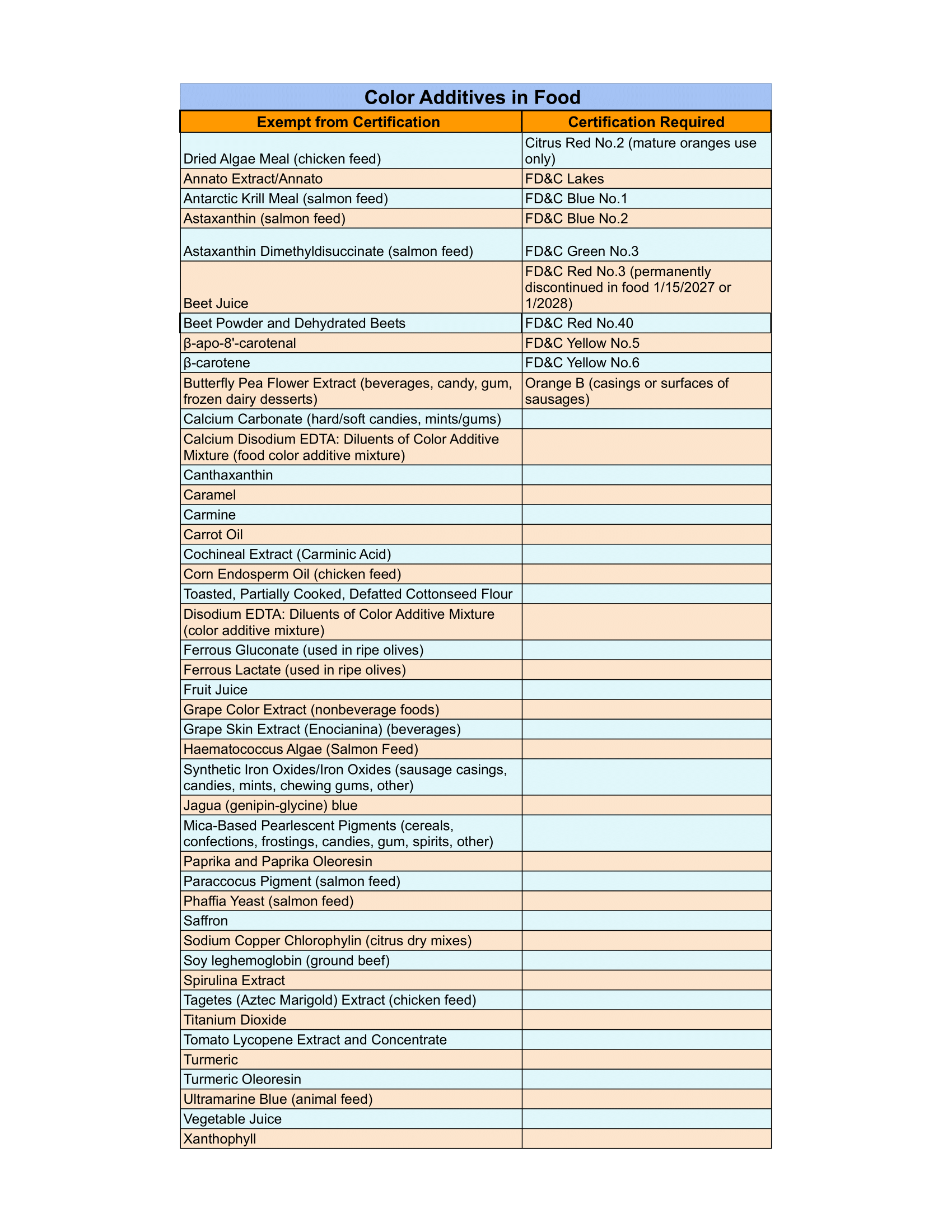The Colors in Our Food
Disclaimer: This article is for educational and informational purposes only. While detailed, the article provided is not inclusive of all information on the subject. It is not intended to treat or cure any ailment, condition, or disease. The link to the sources are listed below.
The bright red found in your fruit punch-flavored soda or mild yellow used in your favorite crunchy pickles is commonplace among grocery store items nationwide. There is an increased interest in colors found in the food we eat in the United States. From reds to blues, there are several colors, both organic and synthetic, that are found within the food supply. Individuals have raised concerns about the safety or potential health issues with some studies showing increased risk of ADHD, hyperactivity (particularly in children), skin rashes, and cancers but research remains inconclusive. The Food and Drug Administration (FDA) is responsible to investigate and review colors to be used in foods for our safety. Keep reading to learn more about color additives found in the food we eat.
What are Color Additives?
As defined by the FDA, color additives are “any dye, pigment, or other substance which when added or applied to a food, drug, cosmetic, or to the human body, is capable (alone or through reactions with other substances) of imparting color”.¹ Color additives are used to enhance the appearance of colors found within food naturally.² Color additives are also used to mask the reduction of pigment that can occur during food processing and storage. This is because the processing and storage of foods can cause the loss of brightness or intensity of colors when exposed to light, air, moisture, and temperature.² Other than enhancement and replacement purposes, color additives are used to make natural colors in foods uniform due to variations found in nature and to provide colors used in colorless or “fun” foods.²
What are the Types of Color Additives?
Color additives can be divided into three categories: straight colors, lakes, and mixtures.¹ Straight colors are pigments, dyes, or substances that are not mixed or chemically altered by any other substance.¹ On the other hand, lakes are pigments, dyes, or substances that are mixed with certified straight colors (except for carmine) to form precipitants or substrata (solid substances that form after a reaction).¹ Mixtures combined two or more color additives in a diluent without a chemical reaction.¹
How are Color Additives Monitored?
Color additives used in food are divided into two categories: certified color additives and color additives exempt from certification.² Both categories of color additives must be approved for safety prior to certification or exemption.² The FDA uses an evaluation process to approve color additives for use, considering the substance’s properties, analysis of the substance’s contaminant level, side effects (short-term and long-term), and proposed amount for consumption.² The FDA also utilizes a built-in safety margin that approves much lower levels of color additives to be used to minimize the chances of an adverse event.² Once approved, the FDA provides limitations on how much and what food color additives can be used in as well as labeling or need for batch testing.² Unlike some food additives, color additives are not required to meet the standards of the Generally Recognized As Safe (GRAS) provision.²
Certified colors are synthetically produced, or human-made, for use in food, drugs, and cosmetics (FD&C).² Certified colors are produced to impart intense, uniform color at a cheaper cost.² In foods, the dyes are chemically classified as azo, xanthene, triphenylmethane, and indigoid.² They are derived from coal and petroleum.²Dyes, pigments, or substances derived from organic/biological sources such as vegetables, minerals, and animals are known to be exempt from certification.² Colors exempt from certification still must follow specifications regarding identification, purification, and limitations.²
There have been many updates of legislature throughout the years regarding color additives; some acts or provisions that involve color additives include the Food and Drug Act of 1906, the Federal Food, Drug, and Cosmetic Act of 1938, and the Color Additive Amendments of 1960.² The FDA continuously monitors color additives within foods and corrects issues that violate any use of color additives through warning letters, detentions, issuance reports, and seizures.²
The FDA also considers emerging data and participates in setting standards for food safety.² Currently, the use of Red No.3 will be banned in Jan 2027 or Jan 2028 due to studies showing cancer in male rats.³ Although cancer from Red No.3 in rats was not shown in humans, the Delaney Clause of 1960 requires the FDA to ban the authorization of food or color additives that induce cancer in animals or humans.³
What Color Additives are in Food Today?
Color additives used in food today can be found on the FDA’s Inventory of Color Additives. Within the food category, colors used as color additives are used in animal feed, salmon feed, foods generally, and specific food items.⁴ The following chart lists color additives found in foods based on certification status with brief descriptions of specific food items (those without descriptions are generally used in foods). Visit the FDA’s Inventory of Color Additives found in food for the most current database results.
Data obtained from FDA last updated 1/22/25
